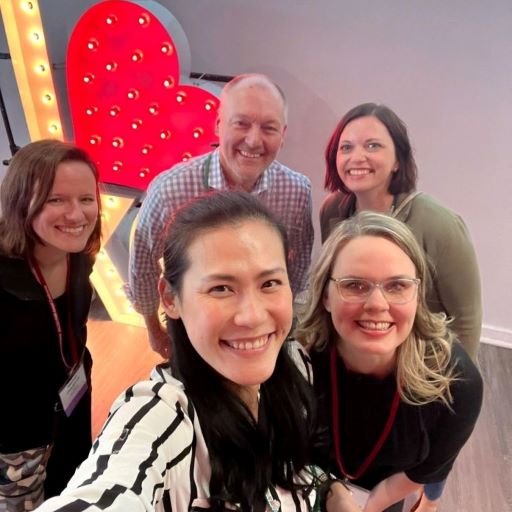
Mariah Obiedzinski Tang
May 9, 2022

The past two years were a pinnacle of storytelling. When many of us were avoiding casual encounters, we relied on stories from trusted institutions and brands to get information and entertainment. Whether heartbreaking, hilarious, or horrifying—remember “Tiger King”?—the pandemic reinforced the role of storytelling as a strong and effective marketing approach.
The storytelling vibe was wildly apparent and welcome at NACCDO-PAMN 2022, the cancer conference’s first in-person meeting since 2019. Anecdotes flew through the event center as friends, colleagues, and clients caught up—some of whom were meeting face-to-face for the first time.
Storytelling was the pulse of nearly every session, from tips for talking with major donors about the results of their philanthropic gifts to preparing faculty for media interviews.
While nearly every presenter and attendee expressed enthusiasm about telling more and better stories, an underlying theme crept into nearly every discussion: “Our subject matter experts (SMEs) sometimes have a tough time understanding why marketing wants to tell their stories.”
But both are rectifiable with smart internal communications and strategic change management:
Researchers, doctors, patients, donors—everyone has a story to tell, and there are varied levels of comfort in doing so, particularly on digital. These individuals might not understand the potential impacts of their stories on a prospective student, patient, or donor. An SME’s story can touch the right person at the right time and influence their decision to enroll, seek care, or give.
Storytelling connects the dots between internal passion and external needs. By properly framing your internal communications and bringing user experience data to the table, you can create a winning storytelling strategy that benefits your SMEs and the public—and ultimately, your strategic goals.
Often, the internal voices with the best stories are the most hesitant to share. Not because they’re shy or too busy. When asked to share stories, researchers, clinicians, advisors, and faculty may seem shocked and reply with statements like:
No times three. People love stories, and a good storytelling partner can help you turn even the most complex or “insider” topic into an accessible piece of content for any audience.
However, what’s typically true is that latent troubadours don’t understand the potential breadth and depth of their stories’ reach. They may not see the vision you have for a local story that has a chance to be picked up by national media. Or they might not think about the lasting search value of a story that seems less-than-newsworthy now but can serve as a cornerstone educational piece for years to come.
When you approach potential subject matter experts (SMEs) in your organization, start by asking them why they’re passionate about the topic at hand. If they can tell you why THEY care, you can identify the story nugget that might resonant most with your audience—and uncover a built-in angle to help the SME build their story.
The SME doesn’t have to “get” every bit of your marketing strategy. They just have to understand that they—and their stories—are important to your institution and to your external audiences. When that clicks, you’ll make a new friend who’s more willing to bring stories to you up front.
In most industries, the people producing your content are not the same as the people receiving it. However, healthcare and higher ed are a bit of an exception to the rule:
But we can’t assume that our experiences mirror everyone else’s. Socioeconomic, cultural, and familial factors weigh into decisions around who gets these audiences’ mindshare—and even how they use your website and other digital properties.
Conducting user journey experience assessments can help you understand the full scope of needs of your audience segments. Put yourself in the shoes of someone with specific needs or questions and navigate the site with these factors in mind. This exercise can help you uncover content gaps and opportunities to 1) tell your story in a more relevant capacity and 2) streamline pathways to connect users with information faster, resulting in a better experience.
Tools such as CrazyEgg can offer valuable, anonymous insights into how site visitors traverse your site. By using heatmaps to track KPIs such as scroll depth, clicks, engagement-related pausing on page, and most engaging calls-to-action, you can gather data to evoke buy-in amongst your internal teams to revise and restructure your content in ways that better meet the needs of your audience.
The best stories can get lost in the shuffle without a proper strategy. Your role as the liaison between the SME and the public is to translate the SME’s passion using digital pathways that resonate with the audience.
Here’s an example. Say your SME is a researcher who has recently co-discovered an incredibly precise way to deliver radiation therapy to the lungs. Your role is to capture passion and function—her dedication to the work alongside its benefits for your audience(s)—and create a flowing narrative that:
You can achieve this type of storytelling without appearing like a marketing machine. A blog is a highly successful vehicle to communicate with audiences at all stages of a decision funnel. By adding scannable headlines and inline links to related content, the audience can scan to the section that matters to them and act now—or remember your institution when they need you.
Yet, you still benefit from the search engine optimization value of the entire piece for each audience segment. Include a personal byline from the SME—not the marketing person or the SME’s Department—for a subconscious personal touch that feels more like one-on-one conversation.
Most institutions don’t need a fancy new setup to better showcase stories. Your content management system likely includes underutilized visual tools such as callout features or accordions that can make content more engaging.
Switching up your storytelling style can be a challenging sell internally. Many people are naturally averse to change, particularly if they aren’t convinced they have stories worth telling.
Josiane Dubois, Internal Communications Specialist at Huntsman Cancer Institute, put this perfectly at her NACCDO-PAMN session: “Create a new table instead of joining an existing one.” Your stories don’t have to fit the “what we’ve always done” mold. In fact, sometimes those stories stand out most.
Have more questions about your content marketing strategy? Schedule time with Mariah Obiedzinski Tang to learn how Stamats can help make your content work smarter for you.
Ready to Get Started?
Reach out to us to talk about your strategy and goals.